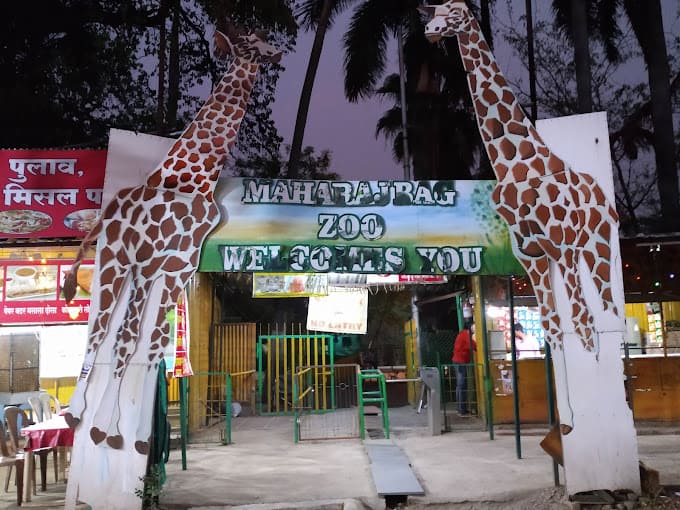Discover Maharaj Bagh Zoo Nagpur: A Historic Wildlife Haven in the Orange City
Nagpur, fondly known as the Orange City, is a vibrant blend of history, culture, and nature. Nestled in the heart of this bustling metropolis lies Maharaj Bagh Zoo Nagpur, a place that’s more than just a zoo—it’s a slice of heritage, a haven for nature lovers, and a family-friendly spot that’s been delighting visitors for over a century. Whether you’re a local looking for a weekend escape or a tourist exploring Nagpur’s treasures, Maharaj Bagh Zoo offers a unique experience that combines wildlife, lush greenery, and a touch of royal history.
In this guide, we’ll dive deep into the story of Maharaj Bagh Zoo Nagpur, its amenities, nearby properties for sale, quick facts, and its plans for expansion. Let’s take a stroll through this iconic destination!
About Maharaj Bagh Zoo Nagpur
Maharaj Bagh Zoo is not just another attraction in Nagpur. It’s a living testament to the city’s rich past. Located on Amravati Road in the Gorepeth area, this zoo and garden complex is a historical landmark that dates back to the 19th century. Here’s a detailed look at its origins and significance:
History of Maharaj Bagh Zoo Nagpur
Royal Beginnings: The story of Maharaj Bagh Zoo begins in 1863, during the reign of the Bhonsle dynasty, which ruled Nagpur for centuries. Initially established as a private menagerie by the Bhonsle rulers, the zoo was part of a sprawling garden attached to their palace, known as Maharaj Bagh (meaning “King’s Garden”). This private collection housed exotic animals like elephants, bears, lions, tigers, and ornamental birds, showcasing the royalty’s fascination with wildlife and nature.
Public Access in the Early 1900s: What started as an exclusive retreat for the Bhonsle elite was opened to the public in 1908, transforming Maharaj Bagh into a zoological park for all to enjoy. The Nagpur Municipal Corporation took over its maintenance, ensuring it became a cherished public space. Over time, the garden was converted into a botanical haven, adding rare herbs, shrubs, and medicinal plants to its repertoire.
A Botanical and Zoological Marvel: By the mid-20th century, Maharaj Bagh Zoo Nagpur had evolved into a unique blend of a botanical garden and a zoo. Managed by the Panjabrao Deshmukh Krishi Vidyapeeth (PDKV) under the Central Zoo Authority (CZA) of India, the zoo became a center for conservation and education. It’s home to nearly 100 species of mammals, birds, and reptiles, including rare and indigenous species, making it a must-visit for wildlife enthusiasts.
Challenges and Resilience: The zoo faced scrutiny in 2006 when the Ministry of Environment and Forests raised concerns about animal healthcare and enclosure standards, threatening closure under the 1998 National Zoo Policy. However, with funding from the Nagpur Municipal Corporation (including INR 1 lakh for a boundary wall), the zoo addressed these issues and was cleared by the CZA in 2007. This resilience underscores its importance to the city and its commitment to improving animal welfare.
Cultural Significance: Beyond its wildlife, Maharaj Bagh Zoo is a symbol of Nagpur’s heritage. Once a playground for colonial officers and Indian elites, it’s now a democratic space where families, schoolchildren, and tourists come together to connect with nature. Its proximity to landmarks like Nagpur Junction and Deekshabhoomi makes it a central part of the city’s identity.
Why Visit Maharaj Bagh Zoo Nagpur?
For Nagpur locals, the zoo is a nostalgic spot many of us have memories of school picnics or family outings here. For visitors, it’s a chance to experience a slice of Nagpur’s royal past while enjoying a serene escape from the urban grind. The zoo’s lush gardens, ancient trees, and diverse wildlife create a tranquil environment that feels like a mini-jungle in the city’s heart.
Amenities at Maharaj Bagh Zoo Nagpur
Maharaj Bagh Zoo Nagpur is designed to be a visitor-friendly destination, offering a range of facilities to make your trip comfortable and enjoyable. Here’s what you can expect:
- Affordable Entry Fees: The zoo keeps things budget-friendly with an entry fee of Rs. 30 for adults and Rs. 15 for children. This makes it an accessible outing for families, students, and tourists alike.
- Operating Hours: The zoo is open daily from 8:00 AM to 6:00 PM (February to August) and 8:00 AM to 5:30 PM (September to January). Note that some sources mention it’s closed on Saturdays, so it’s wise to call ahead at +91-712-2523720 to confirm.
- Parking Facilities: Ample parking is available across the road from the zoo, making it convenient for those driving in. The parking area is well-organized, ensuring hassle-free access.
- Restrooms and Drinking Water: Clean restrooms and drinking water stations are scattered throughout the complex, catering to visitors’ basic needs. These facilities are especially helpful for families with kids or elderly members.
- Food Stalls and Picnic Areas: While policies on bringing food may vary. The zoo generally allows visitors to carry their own snacks, provided waste is disposed of responsibly. Food stalls are available for quick bites, and the expansive lawns are perfect for picnics. The grounds are dotted with seating areas and shaded spots, ideal for relaxing with family or friends.
- Children’s Play Areas: The zoo features dedicated play zones for kids, making it a hit with young visitors. These areas are safe and engaging, allowing parents to relax while kids burn off energy.
- Educational Tours: Schools often organize trips here. As the zoo offers guided tours that educate visitors about wildlife conservation and the region’s biodiversity. The botanical garden, with its collection of medicinal and ornamental plants, is a learning hub for botany enthusiasts.
- Walking Trails: Well-maintained walkways wind through the garden, offering scenic routes to explore the flora and fauna. These trails are perfect for leisurely strolls or morning walks.
- Animal Enclosures: The zoo houses a variety of animals, including Royal Bengal tigers, leopards, lions, monkeys, peacocks, and rare bird species. While some reviews note that enclosures could be larger, efforts have been made to create naturalistic habitats, especially for the tigers, which are a major draw.
Tips for Visitors
- Wear comfortable shoes, as the zoo involves a fair amount of walking.
- Carry a water bottle, especially during Nagpur’s scorching summers.
- Follow zoo guidelines to avoid disturbing the animals and keep the environment clean.
- Visit early in the morning or late afternoon to catch the animals at their most active and avoid the midday heat.

Properties for Sale Near Maharaj Bagh Zoo Nagpur
Given its central location, Maharaj Bagh Zoo Nagpur is surrounded by vibrant neighborhoods like Ramdaspeth, Sitabuldi, Sadar, and Mohan Nagar, making it a desirable area for real estate. Here’s a look at the property market nearby:
Popular Localities: Areas like Ramdaspeth (1.2–1.8 km from the zoo), Sitabuldi (1.9–2.3 km), Sadar (2.3 km), and Wardha Road (1.4 km) are prime residential and commercial hubs. These neighborhoods are well-connected to Nagpur Junction, Dr. Babasaheb Ambedkar International Airport, and other landmarks.
Property Types: You’ll find a mix of apartments, independent houses, and commercial spaces. Budget options like 1 BHK and 2 BHK flats are popular. While luxury villas and 3–4 BHK apartments cater to premium buyers. Commercial properties, such as shops or office spaces, are also in demand due to the area’s proximity to business districts.
Property Rates:
- Ramdaspeth: Average rates for residential properties range from Rs. 5,000 to Rs. 8,000 per square foot. A 2 BHK apartment (800–1,200 sq. ft.) typically costs Rs. 40–70 lakhs.
- Sitabuldi: Prices here are slightly higher, ranging from Rs. 6,000 to Rs. 9,000 per square foot, with 2 BHK flats priced between Rs. 50–80 lakhs.
- Sadar: Known for its upscale vibe, Sadar sees rates of Rs. 6,500–10,000 per square foot. Luxury apartments can cost upwards of Rs. 1 crore.
- Wardha Road: More affordable, with rates between Rs. 4,500 and Rs. 7,000 per square foot. A 2 BHK here may cost Rs. 35–60 lakhs.
- Mohan Nagar: Budget-friendly options start at Rs. 4,000 per square foot, with 1 BHK flats available for Rs. 20–35 lakhs.
Amenities in Nearby Properties: Many modern apartments offer amenities like gyms, swimming pools, 24-hour security, and parking. Hotels like Radisson Blu Nagpur, The Pride Hotel, and Tuli Imperial, located within 1–2 km. Also indicate the area’s appeal for hospitality investments.
Why Invest Here?: Proximity to Maharaj Bagh Zoo, Nagpur Junction (2–3 km), and the airport (7–10 km) makes these areas convenient for families and professionals. The presence of schools, hospitals, and malls like Eternity Mall adds to the livability. Plus, Nagpur’s growing status as a smart city boosts property appreciation potential.
Where to Look: Platforms like NagpurHousing, MakeMyTrip, Goibibo, and local real estate portals list properties near Maharaj Bagh Zoo. For budget-conscious buyers, Mohan Nagar and Wardha Road offer value, while Ramdaspeth and Sadar are ideal for premium investments.
A Local’s Perspective
As a Nagpurite, living near Maharaj Bagh Zoo means easy access to green spaces and a quieter environment amidst the city’s hustle. The area’s connectivity to key spots like Sitabuldi’s shopping hubs or Civil Lines’ administrative offices makes it a practical choice for homebuyers. However, check for noise levels near Amravati Road and ensure proper documentation when buying properties.
Quick Facts on Maharaj Bagh Zoo Nagpur
Here’s a snapshot of essential details about Maharaj Bagh Zoo Nagpur:
- Location: Amravati Road, Maharaja Bagh, Gorepeth, Nagpur, Maharashtra 440010.
- Established: 1863 (as a private menagerie); opened to the public in 1908.
- Area: Spread over 13 acres, including a botanical garden and zoo.
- Managed By: Panjabrao Deshmukh Krishi Vidyapeeth (PDKV) under the Central Zoo Authority (CZA).
- Animals: Home to nearly 100 species, including Royal Bengal tigers, leopards, lions, monkeys, peacocks, and rare birds.
- Entry Fees: Rs. 30 (adults), Rs. 15 (children).
- Timings: 8:00 AM–6:00 PM (Feb–Aug), 8:00 AM–5:30 PM (Sep–Jan); possibly closed on Saturdays.
- Best Time to Visit: October to March for pleasant weather.
- Nearby Attractions: Deekshabhoomi, Raman Science Centre, Nagpur Central Museum, Futala Lake.
- Contact: +91-712-2523720 (verify before visiting).
- Conservation Focus: Emphasizes wildlife preservation and education, with a botanical garden featuring rare plants.
Expansion of Maharaj Bagh Zoo Nagpur
Maharaj Bagh Zoo Nagpur has faced challenges due to its small size and limited funds, but exciting plans are in place to enhance its offerings:
Gorewada Safari Park: The Government of Maharashtra has approved a new international-standard safari park near Gorewada Lake, about 10 km from Maharaj Bagh Zoo. This ambitious project aims to relocate some animals from Maharaj Bagh to larger, open enclosures that mimic their natural habitats. The new park will feature modern facilities and a safari experience, boosting Nagpur’s appeal as a wildlife tourism hub.
Continued Operation of Maharaj Bagh: While some animals will move to Gorewada, Maharaj Bagh Zoo will remain operational, introducing new species and maintaining its botanical garden. This ensures the historic zoo continues to serve locals and tourists.
Past Upgrades: Over the years, the zoo has seen renovations like new enclosures, a veterinary hospital, and beautification drives. The 2007 upgrades, prompted by CZA scrutiny, included a boundary wall to prevent infections and open enclosures for better animal welfare.
Future Plans: Though specific expansion details for Maharaj Bagh itself are limited, the focus is on improving animal habitats and visitor amenities. The zoo aims to enhance its conservation programs and educational outreach, making it a hub for learning about biodiversity.
Challenges: Funding remains a hurdle, as Maharaj Bagh is one of India’s smaller zoos. Visitor reviews suggest that some enclosures need modernization, and the zoo is working to address these concerns while balancing its heritage charm.
What This Means for Nagpur
The Gorewada safari park will elevate Nagpur’s status as a wildlife destination, potentially drawing more tourists and boosting local businesses. Meanwhile, Maharaj Bagh Zoo will retain its charm as a compact, family-friendly spot, perfect for quick visits and educational trips. For locals, this dual approach ensures that the city’s wildlife legacy grows without losing its historical roots.
A Personal Touch: Why Maharaj Bagh Zoo Nagpur Matters
As someone who’s grown up in Nagpur, I can tell you that Maharaj Bagh Zoo is more than just a place to see animals—it’s a part of our city’s soul. I remember my first visit as a kid, wide-eyed at the sight of a Royal Bengal tiger lounging in its enclosure, the air filled with the calls of peacocks. The zoo’s gardens, with their towering trees and colorful flowers, felt like a secret world away from Nagpur’s busy streets. It’s where families bond, kids learn about nature, and couples find a quiet spot for a walk.
But it’s not perfect. Some visitors, including myself, have noticed that the zoo could use more spacious enclosures and better upkeep in certain areas. Yet, the efforts to modernize and the upcoming Gorewada project show that Nagpur is committed to preserving this gem while adapting to modern standards. Whether you’re a parent planning a fun day out, a student curious about wildlife, or a homebuyer eyeing a property nearby, Maharaj Bagh Zoo Nagpur has something for everyone.
Planning Your Visit
Ready to explore Maharaj Bagh Zoo Nagpur? Here’s how to make the most of it:
- How to Reach: The zoo is easily accessible by road. Take a bus, auto-rickshaw, or taxi from Nagpur Junction (2–3 km away) or hire a cab from Dr. Babasaheb Ambedkar International Airport (7–10 km). If driving, use the parking across Amravati Road.
- Best Time: Visit between October and March for cooler weather. Early mornings are ideal for active animals and fewer crowds.
- What to Bring: Comfortable shoes, water, sunscreen, and a camera for those Instagram-worthy shots of tigers or peacocks.
- Nearby Spots: Combine your visit with a trip to Deekshabhoomi, Futala Lake, or the Raman Science Centre for a full day of exploration.
Conclusion
Maharaj Bagh Zoo Nagpur is more than a zoo—it’s a bridge between Nagpur’s royal past and its modern aspirations. From its origins as a Bhonsle menagerie to its role as a beloved public space, the zoo captures the essence of the Orange City’s love for nature and heritage. With affordable entry, family-friendly amenities, and a promising future tied to the Gorewada safari park, it’s a destination that deserves a spot on your Nagpur itinerary.
Whether you’re marveling at a leopard’s grace, strolling through the botanical garden, or considering a home in the vibrant neighborhoods nearby, Maharaj Bagh Zoo Nagpur offers a unique blend of history, wildlife, and community spirit. So, grab your family, pack a picnic, and head to this iconic spot—you won’t be disappointed!











